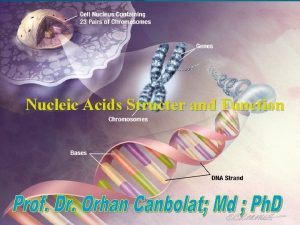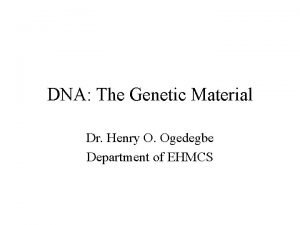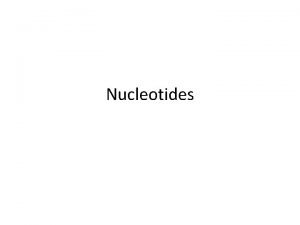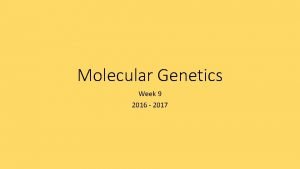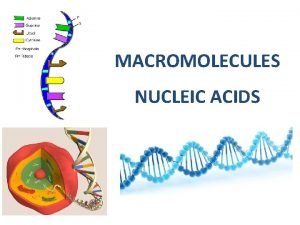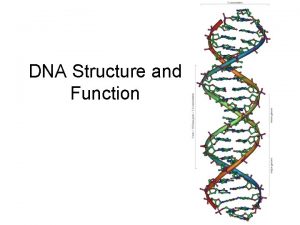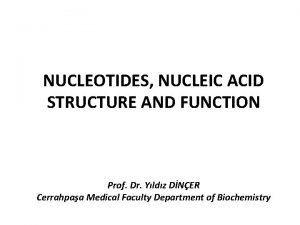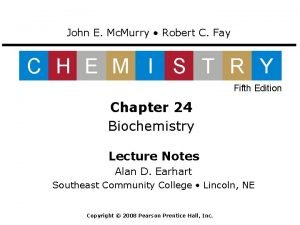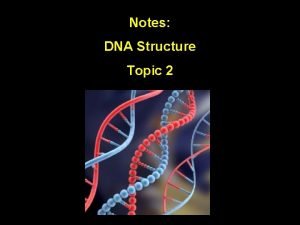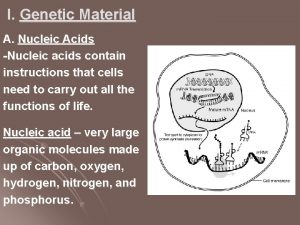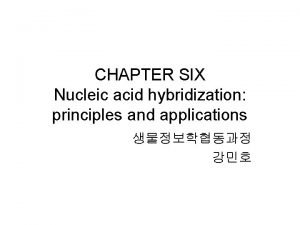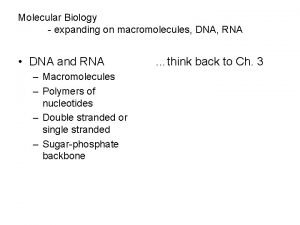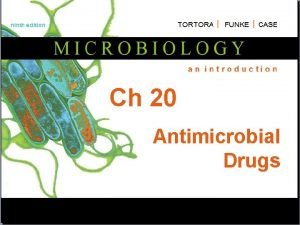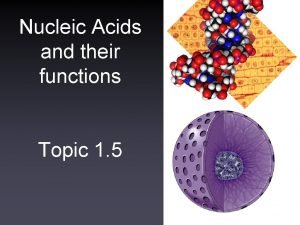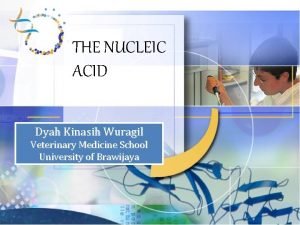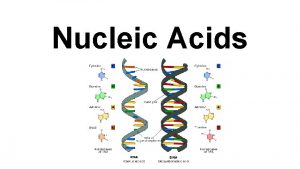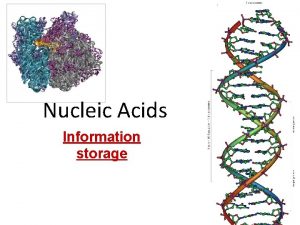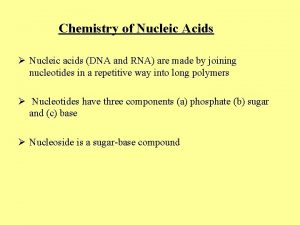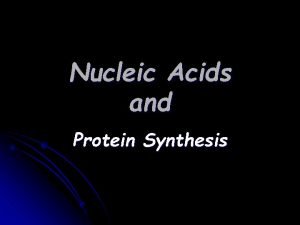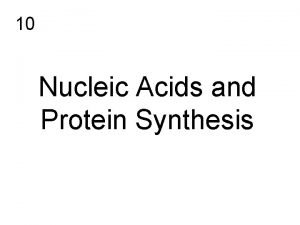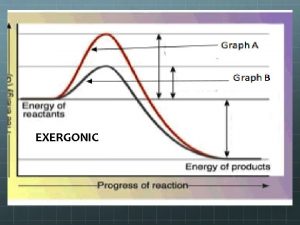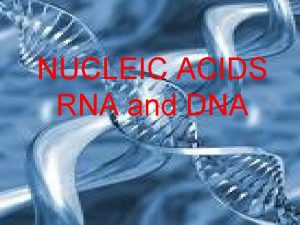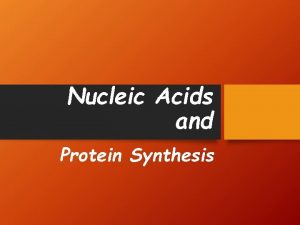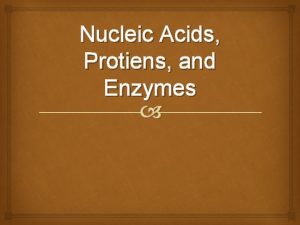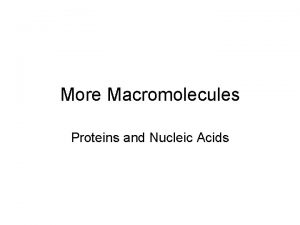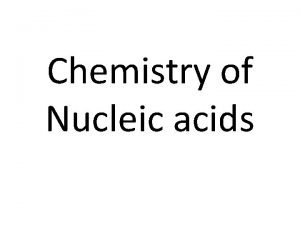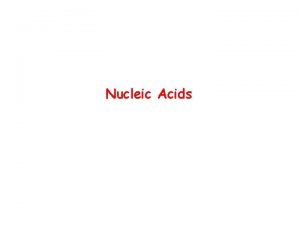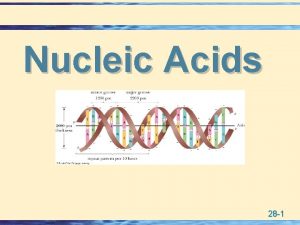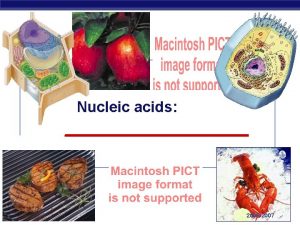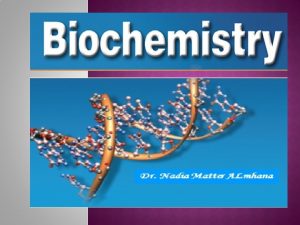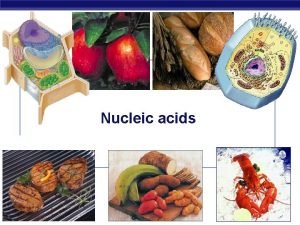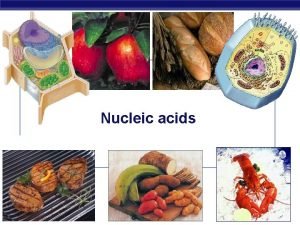Nucleic Acids Structer and Function Nucleic acids structer


























- Slides: 26

Nucleic Acids Structer and Function

Nucleic acids structer and function Biomedical Importance This polymeric molecule, deoxyribonucleic acid (DNA), is the chemical basis of heredity and is organized into genes, the fundamental units of genetic information. The basic information pathway ; DNA directs the synthesis of RNA, which in turn directs protein synthesis — has been elucidated. = Central Dogma Genes do not function autonomously; their replication and function are controlled by various gene products, often in collaboration with components of various signal transduction pathways. Knowledge of the structure and function of nucleic acids is essential in understanding genetics and many aspects of pathophysiology as well as the genetic basis of disease.


DNA is a linear polymer of deoxyribonucleotides in which the sequence of purine and pyrimidine bases encodes cellular RNA and protein molecules. DNA is highly organized into chromosomes, structures that allow the DNA to be packaged tightly for storage in the nucleus of the cell.

DNA The information contained in the DNA is represented by the sequence of the bases of the polymer the purines adenine (A) and guanine (G) the pyrimidines cytosine (C) and thymine (T). The deoxyribonucleotides in the DNA polymer are connected by phosphodiester bonds between the 5′-phosphate group attached to one deoxyribose sugar and the 3′-hydroxyl group of the next sugar. This sugar-phosphate backbone is located on the outside of the structure.

DNA is double-stranded. 1. The two strands run in reverse polarity or antiparallel to each other. 2. The strands are held together by hydrogen bonding between the bases, with a purine always bonded with a pyrimidine in specific base pairs. a. Base pairs have a preferred structural complementarity. b. A pairs with T via two hydrogen bonds. c. G pairs with C via three hydrogen bonds.

Hidrogen bond ; B-B Phosphodiester bonds ; S-P Beta , N-glycosidic bonds ; B-S

Specific Enzymes Digest Nucleic Acids Deoxyribonucleases Ribonucleases Endonucleases Exonucleases Nücleotidase

DNA Double-stranded DNA exists in at least six forms (A–E and Z). The B form is usually found under physiologic conditions (low salt, high degree of hydration). A single turn of B-DNA about the axis of the molecule contains ten base pairs. The distance spanned by one turn of BDNA is 3. 4 nm (34 Å). The width (helical diameter) of the double helix in B-DNA is 2 nm (20 Å).

Double-stranded DNA

DNA In B DNA, the form that occurs most commonly under physiologic conditions the helix has major and minor grooves, which provide access for protein binding to the DNA.


DNA Denaturation. Increased heat, decreased salt concentration, or extremes of p. H can force the DNA duplex to melt open (or “unzip”) by disrupting the hydrogen bonds its percentage of G and C bases, which provide a stronger basepair interaction than A and T pairs.

DNA Compacting of the DNA for storage in the limited space available in the cell’s nucleus is accomplished by binding of proteins 1. A family of small, basic proteins called histones is responsible for major interactions with DNA in the formation of nucleosomes. a. Prokaryotic histones are of five types: H 1, H 2 A, H 2 B, H 3 and H 4; vertebrates also have histone H 5. b. Binding of the positively charged histones to DNA neutralizes negative charges of the phosphate groups along the DNA backbone, which allows the DNA to bend much more easily than naked DNA.

DNA Two molecules each of the similarly sized histones H 2 A, H 2 B, H 3, and H 4 bind together in an octamer that forms the core of a nucleosome. DNA wraps around each nucleosome core 1. 75 times, Approximately 146 base pairs of DNA are involved in forming each nucleosome Various types of histone H 1 (or H 5) bind loosely to the linker regions to help organize the nucleosomes into higher-order structures.

RNA Transcription is the process by which RNA copies of the genes are synthesized as the first step leading to gene expression. Messenger RNAs (m. RNAs) carry copies of the genes that can be translated into proteins Other specialized RNAs, ribosomal RNA (r. RNA), transfer RNAs (t. RNAs), and small RNA molecules are not translated into protein but have central roles in gene expression and protein synthesis. In eukaryotes, m. RNAs are initially transcribed as heterogeneous nuclear RNA( hnm. RNA) , which still contains intervening sequences of the gene and must undergo processing to attain the final m. RNA structure. small nuclear RNA (sn. RNA) are not directly involved in protein synthesis but play pivotal roles in RNA processing.

RNA The features of RNA structure that distinguish it from DNA follow: a. Presence of ribose as the sugar in the backbone of RNA rather than 2′-deoxyribose as in DNA. b. Thymine (T) in DNA is replaced by uracil (U) in RNA. c. RNA is a single-stranded version of one strand of the DNA sequence, at least as initially synthesized. d. RNA can form complex, variable secondary structures by internal foldback and intramolecular base pairing between complementary regions of the molecule. e. Most types of cellular RNA are involved in various steps in protein synthesis or gene expression.

Messenger RNA The expression of genetic information in DNA into the form of an m. RNA transcript. This is subsequently translated by ribosomes into a specific protein molecule.

Messenger RNA The 5' terminal of m. RNA is "capped" by a 7 - methylguanosine triphosphate The cap is involved in the recognition of m. RNA by the translation machinery, and it probably also helps stabilize the m. RNA by preventing the attack of 5'-exonucleases. The protein-synthesizing machinery begins translating the m. RNA into proteins beginning downstream of the 5' or capped terminal.

Messenger RNA The other end of most m. RNA molecules, the 3'-hydroxyl terminal, has an attached polymer of adenylate residues 20 – 250 nucleotides in length. it seems that it maintains the intracellular stability of the specific m. RNA by preventing the attack of 3'-exonucleases. Some m. RNAs, including those for some histones, do not contain poly(A). Both the m. RNA "cap" and "poly(A) tail" are added posttranscriptionally by nontemplate-directed enzymes.

Heterogeneous nuclear RNA These nuclear RNA molecules, precursors to the mature, fully processed m. RNAs, are very heterogeneous in size and are quite large. hn. RNA molecules are processed to generate the m. RNA molecules which then enter the cytoplasm to serve as templates for protein synthesis.

Transfer RNA (t. RNA) t. RNA molecules vary in length from 74 to 95 nucleotides. The t. RNA molecules serve as adapters for the translation of the information in the sequence of nucleotides of the m. RNA into specific amino acids. There at least 20 species of t. RNA molecules in every cell, at least one (and often several) corresponding to each of the 20 amino acids required for protein synthesis.

Transfer RNA All t. RNA molecules contain four main arms. The acceptor arm terminates in the nucleotides Cp. AOH. The t. RNA-appropriate amino acid is attached, or "charged" onto, the 3'-OH group of the A moiety of the acceptor arm. The anticodon, T C, and dihydrouracil (D) arms are indicated, as are the positions of the intramolecular hydrogen bonding between these base pairs.

Ribosomal RNA Ribosomes are large nucleoprotein machines composed of large and small subunits that carry out protein synthesis. Prokaryotic ribosomes contain three r. RNAs: 16 S r. RNA in the small (30 S) subunit and 23 S and 5 S r. RNA molecules in the large (50 S) subunit. Eukaryotic ribosomes contain four r. RNAs analogous to those in prokaryotes: the 18 S r. RNA of the small (40 S) subunit and the 28 S, 5. 8 S, and 5 S of the large (60 S) subunit.

Small RNA sn. RNAs are significantly involved in m. RNA processing and gene regulation. Of the several sn. RNAs, U 1, U 2, U 4, U 5, and U 6 are involved in intron removal and the processing of hn. RNA into m. RNA The U 7 sn. RNA is involved in production of the correct 3' ends of histone m. RNA

Micro RNAs - si. RNAs Play important roles in gene regulation. Presently, all known mi. RNAs and si. RNAs cause inhibition of gene expression mi. RNAs are typically 21– 25 nucleotides in length and are generated by nucleolytic processing of the products of distinct genes/transcription units Leading via unknown mechanisms to translation arrest. To date, hundreds of distinct mi. RNAs have been described in humans. Micro RNAs - si. RNAs. Both mi. RNAs and si. RNAs represent exciting new potential targets for therapeutic drug development in humans.
 Structer of dna
Structer of dna Importance of nucleic acid
Importance of nucleic acid Function of nucleic acids
Function of nucleic acids Purpose of nucleic acid
Purpose of nucleic acid Biological importance of nucleotides
Biological importance of nucleotides Hystonic
Hystonic What is an anticodon
What is an anticodon Nucleic acid building blocks
Nucleic acid building blocks Polymer structure of nucleic acids
Polymer structure of nucleic acids Ribonucleotide vs deoxyribonucleotide
Ribonucleotide vs deoxyribonucleotide Dna rna
Dna rna Properties of nucleotides
Properties of nucleotides Store and transmit genetic information
Store and transmit genetic information Picture of a macromolecule
Picture of a macromolecule Nucleic acids
Nucleic acids Nucleotide structure labeled
Nucleotide structure labeled Nucleic acid made up of
Nucleic acid made up of Dideoxyribonucleic
Dideoxyribonucleic Hepatic lobules
Hepatic lobules Colony hybridization
Colony hybridization Nucleic acid polymer
Nucleic acid polymer Glycopeptide
Glycopeptide Nucleic acid monomer
Nucleic acid monomer Nucleic
Nucleic Nucleic acid test
Nucleic acid test Infectious nucleic acid
Infectious nucleic acid Nucleic acid
Nucleic acid
